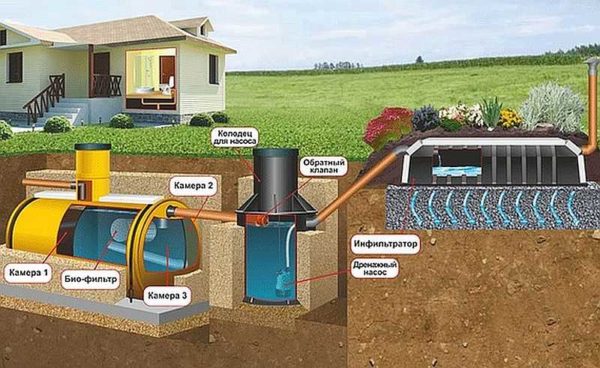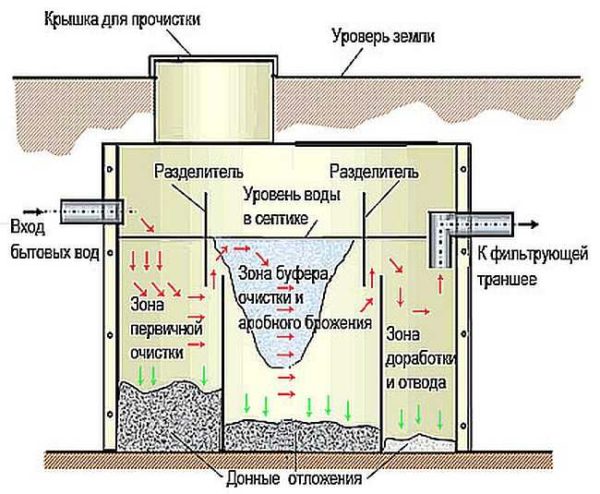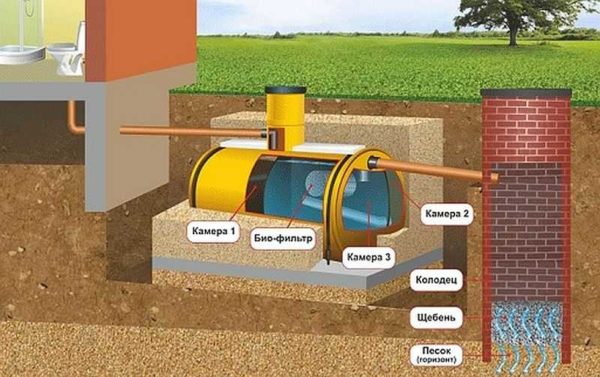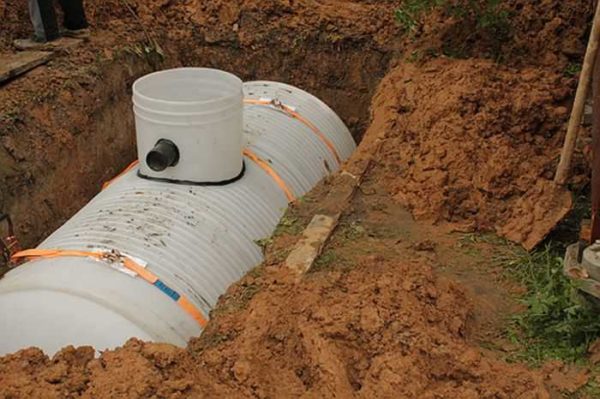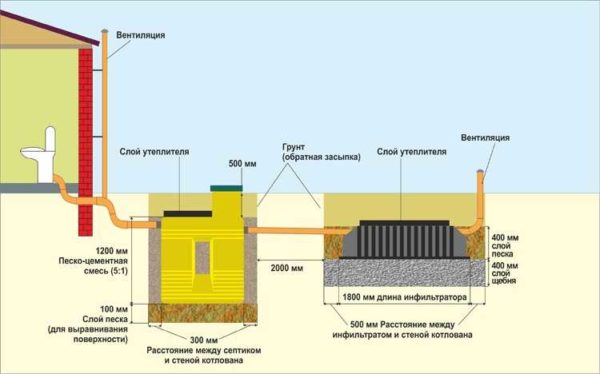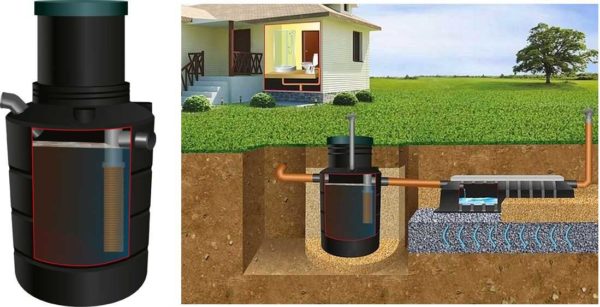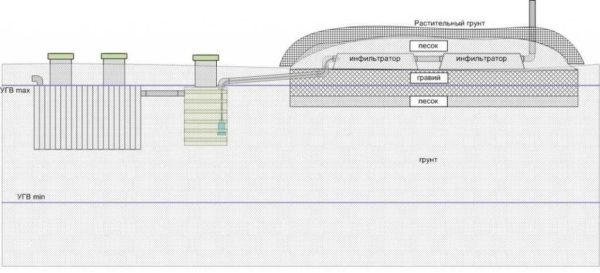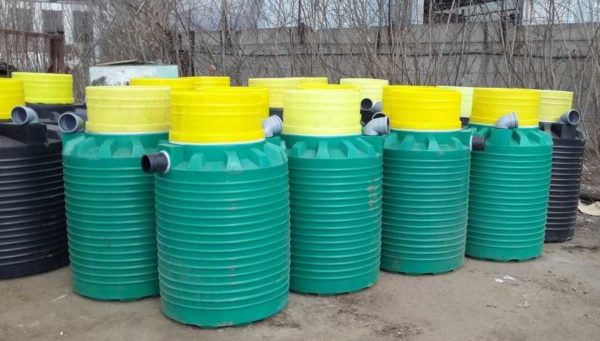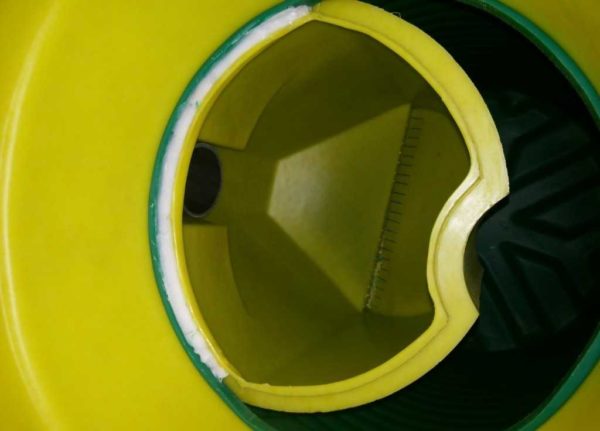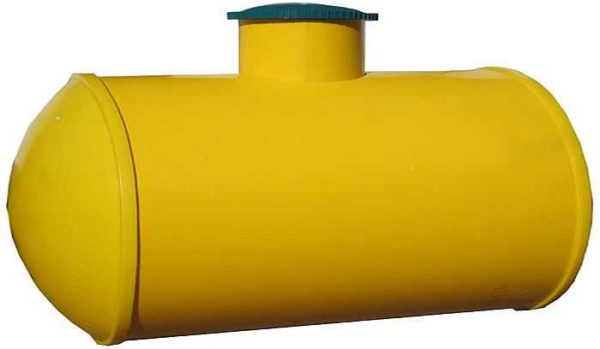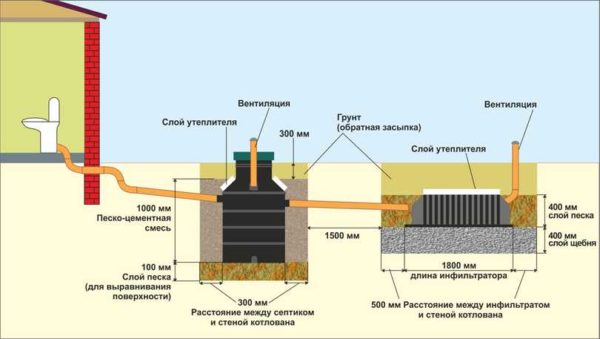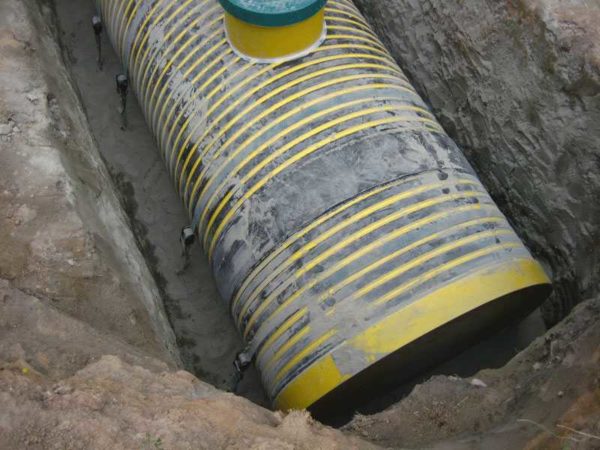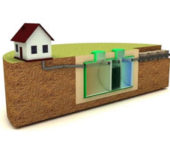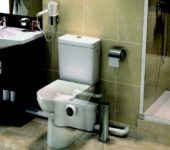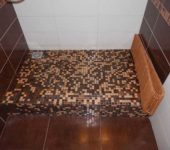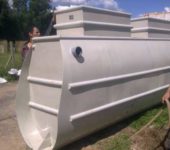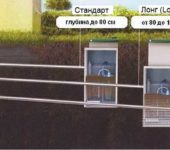Non-volatile septic tanks Triton
To organize an individual sewage system in a country house or in a private house, a container is needed in which the drains will be stored or processed, purified, and the treated water will go into the ground. In either case, you can put a septic tank Triton. They just need different types for different purposes. Accumulative ones are suitable for collection, traditional ones for waste processing.
The content of the article
How septic tanks work
Classic septic tanks - which Triton is - produce only partial purification of effluents. The outlet water can only be called clean. The average degree of cleansing is 50-60%. During normal operation of the septic tank, it should be transparent and odorless, but it cannot be used without additional purification. It is not even suitable for technical needs. In order to somehow use it, additional treatment is required. Most often, clarified wastewater after a septic tank is diverted to filtering devices - a well, a platform, a ditch, and is discharged into the ground through infiltrators, drainage tunnels.
How are drains in a septic tank cleaned
The septic tank Triton is divided into two or three compartments, depending on the model. The first - the largest - is the drive. Wastes from the house enter it through the inlet pipe. In it, organic matter is fermented, gradually decomposed by bacteria that live in the waste. In this case, the solid components begin to decompose / disintegrate, settle to the bottom. Particles containing fats are also released. Since they are lighter than water, they rise to the surface, forming a film / crust there, which creates ideal conditions for the life of bacteria.
Thus, it turns out that in the middle there is more or less pure water. Therefore, it is in the middle part of the partition (slightly closer to the top) that an overflow is made, through which relatively clean water enters the next compartment. In it, the process continues - solid particles precipitate, fat-containing ones rise up. Even lighter water is poured into the third compartment, where the final clarification of the effluents takes place. Further, the effluents are sent for additional treatment, since the level of purification does not allow them to be used in any other way.
As in the case of a storage tank, a classic septic tank needs periodic pumping of the accumulated sludge using a sewage machine. It's all about the time interval that passes between procedures. For a storage tank, you may need a car every month, and for a septic tank - once a year, maybe a little more often - depending on the intensity of use.
Where to drain water
From the outlet of the septic tank Triton, water can be diverted:
- Into the filter well. This is possible if the soils on the site drain well water (sand, sandy loam) and groundwater is deep. There must be a distance of at least one meter from the bottom of the well to the water at its highest point. Under the filter well, a pit is dug about 50-60 cm deeper than required, rubble is poured at the bottom, rings are placed on it (without a bottom). The bottom ring can be perforated. In this case, the distance between the wall of the pit and the well must also be filled with crushed stone to the height of this ring. This prevents the holes from getting silted up and draining water more efficiently.
- On the filtration field. This option is suitable for poor soil absorbency and / or high groundwater levels. The soil is removed to a certain depth, sand and gravel are filled in. Perforated plastic pipes are laid on top.The number of "threads" depends on the volume to be taken away. One is long - no more than 12 m at the end of the field, a ventilation pipe is placed, at least 70 cm high.
- Filtering ditch. From it, you can collect purified water into a well, and then use it as a technical one (for watering a lawn, washing a car, etc.). A ditch is dug, covered with rubble. Perforated supply pipes are laid into it on one side, and drainage pipes on the opposite side. The drainage pipe goes to the storage well. This is also an option for poorly water-conducting soils and high groundwater levels.
- Infiltrators or drainage tunnels. Suitable for installation on any soil. These are plastic perforated containers through which water goes into the ground. They are also placed on a crushed stone pillow (min thickness 40 cm), have a high performance due to the presence of a large number of holes in the bottom and side walls.
Any method is suitable for post-treatment of effluents, but it must be remembered that the installation of such structures requires a lot of money. Moreover, after a few years, the crushed stone will silt up, you will have to replace it with fresh one. If there is one more unpleasant feature: after a few years, filtration fields accumulate so much deposits that they begin to "smell" very strongly. Therefore, replacement of crushed stone may have to be done not in 3-5 years, but faster.
Septic tank Triton: lineup
The body of the Triton septic tank is made of low pressure polyethylene. This means that the material is durable, resistant to stress, does not break under pressure, withstands negative temperatures (up to -30 ° C), that is, the septic tank Triton is not afraid of freezing and can be successfully used at the summer cottage.
Triton Mini
For small summer cottages with accommodation / stay of 1-2 people, large volumes are not needed. According to the norms, the consumption in the city per person is 200 liters per day. At the dacha, this figure is much less - 120-150 liters will be enough with a large margin. Again, according to the standards, the volume of the septic tank should be equal to three times the volume of wastewater per day. At the dacha, even with 2-3 people, you will not use up more than 700 liters in three days. Based on these considerations, the Triton Mini septic tank was designed. Its characteristics are as follows:
- volume - 750 liters;
- processing per day - 400 liters of wastewater;
- salvo discharge - no more than 500 liters;
- dimensions 1250 * 820 * 1700 mm;
- weight - 85 kg.
This is a single chamber septic tank. Since the degree of processing in one chamber is very low - about 20-30%, a biofilter is installed in the second part of the building. This is a floating type device, in the tank there is a biological filling, which improves cleaning. From the outlet of the Triton Mini septic tank, wastewater is diverted to one of the filtration devices, or to infiltrators offered by the same manufacturer.
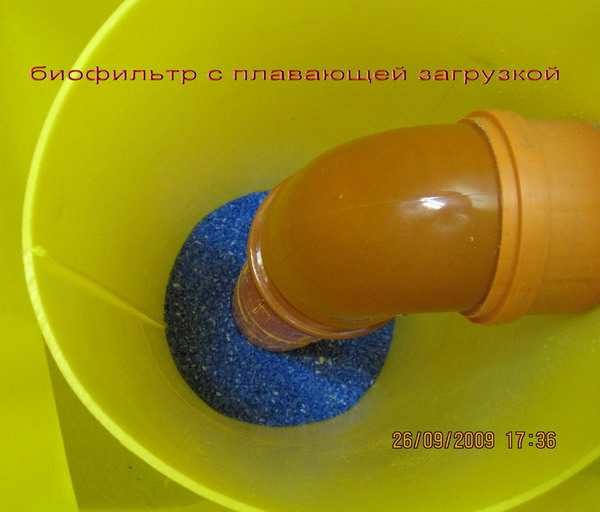
The container contains a biologically active filling. It is essential for better wastewater treatment
Even with such a device, the degree of wastewater treatment will be very low. The filtering devices will clog up very soon, you will have to change everything or build new ones. The situation can be improved by the use of biological products that improve processing. But you need to select them carefully - they must multiply without oxygen (anaerobic bacteria). Usually it is written on the packaging that they are suitable for cesspools and septic tanks of the classic type.
Triton Micro
Triton Micro has an even smaller volume. This is generally one filter chamber without any additional devices. The degree of effluent purification will be very low - no more than 20-25%. If you take such drains to filtration fields, then they (fields) will stink mercilessly. The solution is the same - to add bacteria, but it is better to put a three-chamber septic tank (or three such single-chamber ones, interconnected by overflow pipes, but it will come out more expensive).
Parameters of septic tank Triton Micro:
- volume - 450 liters;
- processing per day - 150 liters of wastewater;
- salvo discharge - no more than 180 liters;
- dimensions 860 * 1500 mm;
- weight - 40 kg.
In general, this version of a septic tank without modification will not give a normal level of wastewater treatment. It can be recommended for use only with a solid post-treatment system, and its device will cost much more than buying a three-chamber septic tank of small volumes.
Another option for using Micro-Triton is as a storage well when installing a more complex cleaning system, when after the septic tank comes out, a storage well is installed, and from it with the help fecal or a drainage pump is pumped onto the bulk filtration fields. Such a device is necessary for a high level of groundwater and poor conductivity of soils.
Triton Microbe
Apparently taking into account the low degree of purification with the Micro model, the manufacturers removed it from production, replacing it with the Microbe model. This version has more powerful ribbing and two chambers, and the inlet pipe is brought out higher, which is more convenient during installation.
Two cameras are better than one, even though it is vertically split. It should be noted that in the usual configuration, a 300 mm high neck is welded (by order, they can be made 500 mm high). A low neckline is not always convenient. Sewer pipes should go downhill from the house about 2cm per meter. According to sanitary standards, septic tanks should be located quite far from the house. If it is at a distance of no more than 10 meters, this neck is enough for you (the inlet pipe takes at least 10 cm). If not, you will have to be wise or ask to weld a higher neck.
The relatively low throat is also bad in that the thickness of the earth layer above the septic tank decreases. Therefore, the insulation of its upper part during installation should be of better quality.
This model already has several variations - for different volumes.
| Name | Volume | How much waste can be processed per day | Weight | Dimensions | Price |
|---|---|---|---|---|---|
| Microbe 450 | 450 l | 150 l | 35 kg | 810 * 810 * 1430mm | 135 (promotional) -240 $ |
| Microbe 650 | 650 l | 200 l | 42 kg | 910 * 910 * 1430mm | 175 (promotional) -295 $ |
| Microbe 750 | 750 l | 250 l | 48 kg | 1010 * 1010 * 1430mm | 200 $ (promotional) -335 $ |
| Microbe 950 | 750 l | 300 l | 54 kg | 1110 * 1110 * 1430mm | 220 $ (promotional) -365 $ |
| Microbe 1200 | 1200 l | 450 l | 80 Kg | 1380 * 1170 * 1840mm | 240 $ (promotional) -320 $ |
| Microbe 1800 | 11800 l | 800 l | 110 kg | 1980 * 1170 * 1840mm | $ 315 (promotional) -350 $ |
The area of use of these septic tanks is for small summer cottages or detached structures - for baths, garages, guest houses, etc. The best option if gray drains will merge here (without flushing from the toilet). Then two cleaning chambers will suffice. If, say, there is a toilet in the same bathhouse, it is not worth dividing the drains, they are better processed together.
Triton T
Triton T is a classic three-chamber plastic septic tank. The version is vertical, the body is made of the same low pressure plastic. The first chamber takes up almost half of the volume, the second half is divided into two parts by a partition. With such a structure, the degree of purification should be standard - about 50-60%.
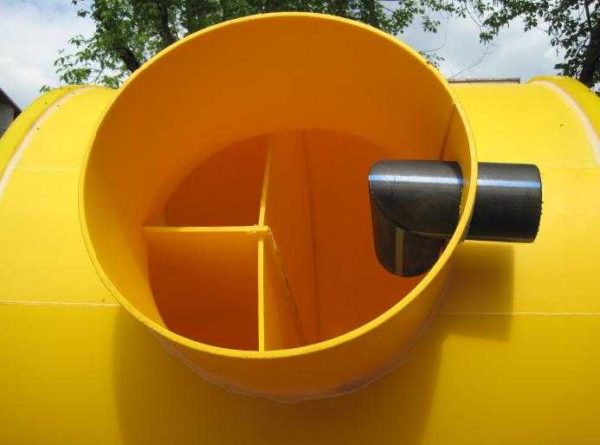
Septic tank Triton T - a classic type of container for processing wastewater from home or summer cottage
Of the features - oval ends. They resist crushing loads better than flat ones. In this group, there are septic tanks of different sizes - from small ones for 2-3 people, to huge ones for dozens of people.
| Name | Volume | Dimensions | How many people |
|---|---|---|---|
| T-1 | 1000 l | 1200 * 1170mm | 2 pax |
| T-1.5 | 1500 l | 1200 * 1620mm | 3 pax |
| T-2 | 2000 l | 1200 * 2020 mm | 4 pax |
| T-2.5 | 2500 l | 1200 * 2520mm | 5 pax |
| T-3 | 3000 l | 1200 * 2920mm | 6 pax |
| T-4 | 4000 l | 1200 * 3820mm | 8 pax |
| T-5 | 5000 l | 1200 * 4720 mm | 10 pax |
This version of the septic tank is suitable in terms of volume for houses with permanent residence. The dimensions are much larger than the mini models described above.
Triton-N - cumulative
In the simplest version, a septic tank is just a storage tank into which drains are diverted. As necessary, a sewer truck is called and the contents are pumped out. For this option, there are storage septic tanks Triton-N.
| Name | Volume | The size | Wall thickness | Price |
|---|---|---|---|---|
| N-1 | 1000 l | 1200 * 1070mm | 14 mm | 380$ |
| H-1.5 | 1500 l | 1200 * 1620mm | 14 mm | 450 $ |
| H-2 | 2000 l | 1200 * 1620mm | 14 mm | 500$ |
| H-3.5 | 3500 l | 1250 * 3100mm | 14 mm | 890$ |
| H-4 | 4000 l | 1200 * 3820mm | 14 mm | 1120$ |
| H-5 | 5000 l | 1200 * 4720 mm | 14 mm | 1450$ |
| H-6 | 6000 l | 1500 * 3600mm | 25 mm | 1650$ |
| N-7 | 7000 l | 1500 * 4200mm | 25 mm | 1820$ |
Installation
Since the septic tank Tank and Triton are produced by the same company, their installation is very similar. The manufacturer recommends not anchoring small vertical models Mini and Microbe, but placing them on a sand bed with a layer of 10 cm. Larger T-grade containers should be placed on a poured (installed) reinforced concrete slab. The procedure for installing small septic tanks is as follows:
- We dig a foundation pit 30-35 cm larger than the dimensions of the container. In depth, it should be 10 cm deeper. Determining the depth, keep in mind that the cover should be on the surface.
- We dig trenches for sewer pipes - inlet from the house and outlet - to the post-treatment device. If you use plastic pipes with a diameter of 100 mm, they must have a slope of at least 2 cm.
- The bottom of the pit is leveled, compacted (by ramming to high density). Sand is poured onto the compacted soil with a layer of 5 cm, leveled and spilled. Then, in the same way - the second layer. It is leveled.
- Install a septic tank, check whether it has become even by placing a level on the neck. It is necessary to check in all planes.
- Connect pipes.
- Pour water into the container. When its level reaches 20-25 cm, we begin filling.
- They begin to fill the distance between the walls of the pit and the container with a mixture of sand and cement. For 1 part of cement, take 5 parts of sand. This mixture is filled with layers of 20-30 cm. Lay the mixture in a circle (along the perimeter), carefully tamping. It is forbidden to use equipment for ramming - only manual ramming. The entire gap is filled in layers. When working, make sure that the water level in the septic tank is 25-30 cm above the level of the backfill.
- Having reached the horizontal surface, insulation is laid on the body. Usually it is expanded polystyrene. The density needs to be high - it should not crumple under the mass of earth, which will be laid on top. The thickness depends on the region; 5 cm is enough for Central Russia.
- Top can be laid geotextile... It will not let the roots grow into the insulation and destroy it.
- Then everything is covered with "native" soil.
Features of installation of large containers
This is the whole process of installing a small septic tank - Mini and Microbe. If we are talking about the installation of Tver-T or Tver-N, a reinforced concrete slab is installed / poured at the bottom of the pit after a layer of sand (do not forget to adjust the depth of the pit). There should be loops on the plate to which a tape-type cable is tied (the usual one does not fit - it does not withstand the load). These cables tie the septic tank to the stove - anchors. This is a way to protect against the emergence of an empty septic tank when the water table is high.
After that backfilling begins. In general, you need to pay special attention to the backfill - there should be no foreign inclusions in the sand. The quality of the backfill will determine whether your septic tank will stand or crush it. Most of the destroyed septic tanks were installed with violations. And the main thing - large pieces of foreign rock in the backfill.
The sand-cement backfill, under the influence of moisture from the soil, turns into a sarcophagus, which keeps the container from floating and protects its walls from the pressure of the rock. If there are gaps in this protection, water seeps out, erodes the protection and sooner or later destroys the container.

